UCSD Extension Summer 2011
Presented in partnership with UCSD Extension K-12 College Exploration.
Creative Computing 101: Learning to Make Interactive Graphics with Code
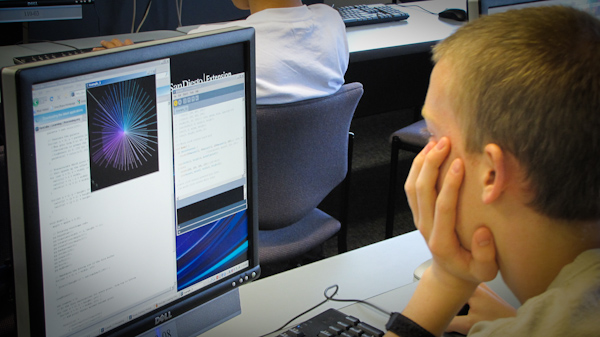
Learn about the basics of coding by exploring the Processing Development Environment. This project-based class will focus on the development of fundamental programming skills, creation of applets that feature interactivity, allowing students to create responsive virtual environments. Students will also learn about interface and interactivity through the creation and use of infrared pens and IR-detecting cameras. Additionally, ways in which we commonly interact with the virtual environment will be explored through the dissection of a Wiimote™ and identification of its electronic features. Students will produce at least one final applet that they will be able to manipulate via the infrared controller that they have created. This class is beginner-friendly and hands-on.
[Learn more…]
Creative Computing 102: Creating Your Own Interactive Installation
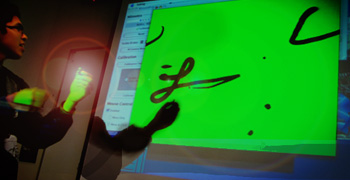
Make an interactive display that responds to your movements or commands! Make environments come alive in the same way that professionals are able to with cutting edge interactive technology that you can design.
Creative Computing 102 is a continuation of Creative Computing 101. It builds on the programming knowledge acquired in 101 for students to create an installation that is able to respond to complex sets of input conditions, perform algorithmic and procedural processing and generate real time output. While this may sound complex, the course takes a hands-on approach, stepping students through the process of discover and application. Students will learn how to combine hardware and software in a collaborative project.
This course is developed around two tools: Processing, a Java-derived programming language for visual thinkers, and Arduino, a hardware platform for working with electronics. Students will learn how to use these tools together by building an interactive installation. Students will learn technical skills in programming and serial communication. They will gain a deeper understanding of how collaboration can enrich information in devices and enhance creativity in people. Assigned projects will explore sensors, interfaces, graphics and electronics.
[Learn more…]
3D Modeling and Animation Using 3D Max
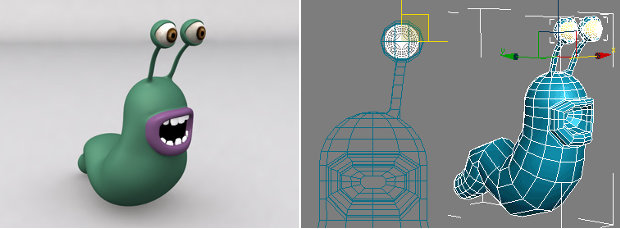
Learn how to design like a video game animator, architect, industrial designer or engineer! In this course, students will learn 3 dimensional principles and apply them in the creation of 3D representations using Autodesk’s 3ds Max. This course will give students the opportunity to create 3D objects and 3D scenes. Students will arrange 3D objects in environments, and gain understanding of how these skills translate into animations for games or visualizations. This course will introduce students to the principles of 3D animation and rendering, and students will learn how to manipulate objects in space to create realistic virtual scenes.
[Learn more…]
Create Wearable Electronics
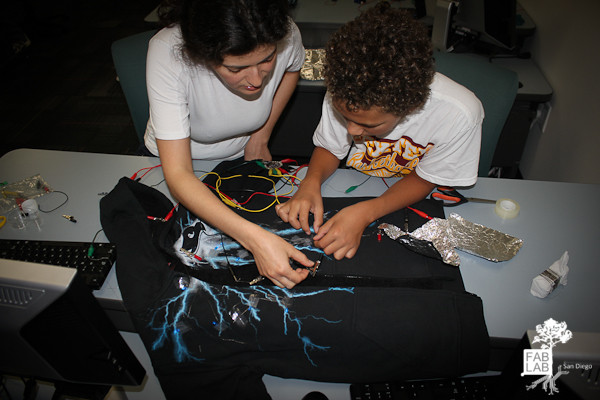 Learn about electronics and microcontrollers the fun way while making your t-shirt talk, your hat tell you the temperature, or your shoes light up with every step!
Learn about electronics and microcontrollers the fun way while making your t-shirt talk, your hat tell you the temperature, or your shoes light up with every step!
‘Wearable Electronics’ is a project-based course focused on the use of electronics on textile surfaces. In addition to being a good introduction to electronics, this class is hands-on: students will create their own wearable projects, using the Arduino microcontroller. By the end of this course, students will have an intermediate level understanding of electronic and programming concepts, including, but not limited to: switches, sensors, networks, embedded systems and the “Arduino” microcontroller. While the course is fast-paced, it is a fun and hands-on application of learning, and students will be given thorough context and reference materials as well as personal assistance in class.
[VISIT THIS CLASS PAGE…]
![]()
Do It Yourself Robotics
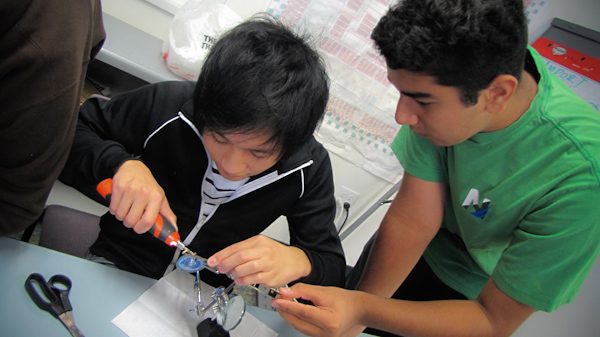 Do you think it is possible to make a robot from your own vacuum cleaner? This workshop will show you how!
Do you think it is possible to make a robot from your own vacuum cleaner? This workshop will show you how!
DIY Robotics is a course for students to learn how to design, build, and modify electronic circuits starting from the ground up. Topics include learning about the basics, transistors, and op-amps. We will begin with looking into the inside of obsolete electronics by opening them up and identifying their parts. Students will then reverse engineer the existing circuits to make their own modified version of the project. Over the sessions of the course, students will learn about the theories and concepts of electricity and electronics, as well as the fundamentals of microprocessors. At the end of the course, students will have created your own mechanical, electrical, and kinetic sculpture, widget or invention and learned about designing, engineering and electronics in the process!
[VISIT THIS CLASS PAGE…]
Creating a Narrative for New Media
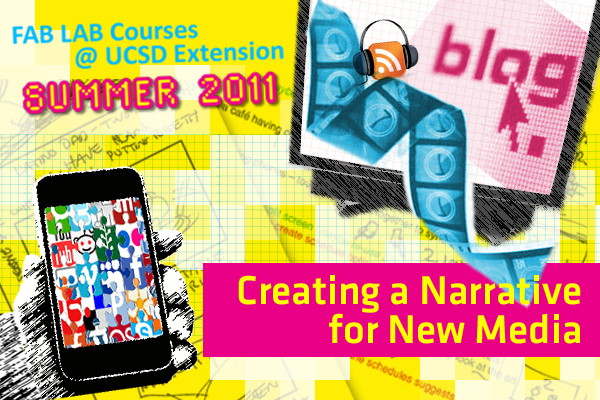
Learn to make your own Podcasts and Webisodes!
The media through which narrative messages are transmitted are advancing—evolving—and expanding by type and capability, by measures of weeks and months, rather than years and decades. This course will review the history of narrative communication from a holistic perspective, summarizing the myriad “forms” of communication that people have used to tell their stories over time and how those story structures have evolved to suit the media. Narrative Structures in New Media will involve the creation of narratives designed for the present new media zeitgeist: Vimeo, Youtube, Facebook, Blogs, Podcasts, Webisodes, Internet Radio and devices including smart phones.
[Learn more…]
![]()
Digital Drawing: Beyond Photoshop
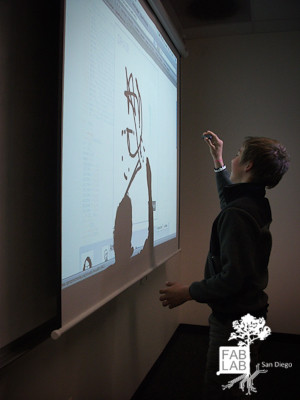
Explore drawing beyond 2D! While we will learn in this class about drawing bold and expressive graphics using industry leading software such as Adobe Illustrator and Photoshop, this class will take you into the world of the technology used for gesture recognition – and explore cutting edge techniques that will allow you to draw in 3D environments!
Students will explore traditional hand-drawing techniques and modern styles, as well as 2 and 3-dimensional drawing methods. Through hands-on projects, students will learn about gesture, and translate that knowledge into digital drawing, using an innovative method of gesture recognition to ‘trace’ their hand movements. Students will also develop an understanding of industry-standard raster and vector editing software, computer interface and interactivity. Students will take a journey from traditional drawing by hand, into media, messaging and the tools of the trade, concluding with a peek into advanced methods of drawing in 3D using gesture analysis and motion data.
[Learn more…]
Making Vectors into Art: An Introduction to Adobe Illustrator
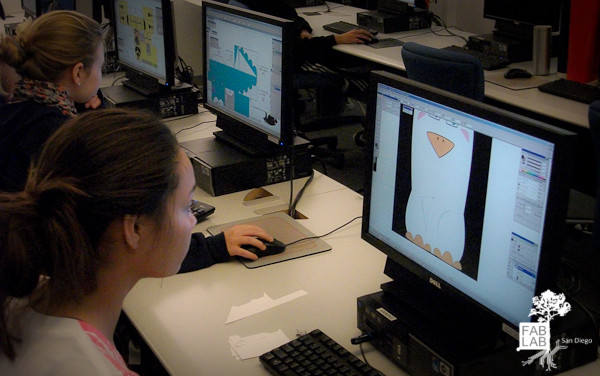
Draw it in the computer, print it in real-life! Learn how to make the vector drawings that you create in Adobe Illustrator become real objects. By using vector art to generate toolpaths, we can create exact replicas of your art with a CNC machine, producing artistic and functional objects that you can keep.
This course provides students with a general understanding of Adobe Illustrator and vector art. Techniques taught in this workshop are geared towards the fields of illustration, animation, and graphic design. Photoshop does similar thing with pixels, but vectors are different because they can be enlarged to any size (even the size of a billboard) without losing quality. We won’t stop there, as we want to explore how we can create physical objects form our designs. Vectors are incredibly helpful creating 2D designs with a computer that can be traced or cut by a computer-numerically-controlled machine, resulting in a chance to witness production of your unique designs first-hand.
[Learn more…]
Introduction to Electronics: Create Your Own Controller!
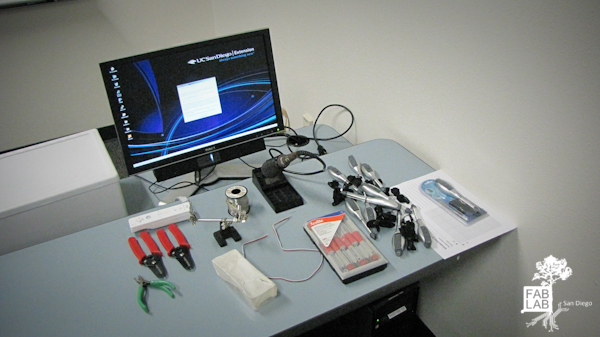
Electronics 101 is a beginner’s overview of the use of electronics. Over the sessions of the course, students will learn about the theories and concepts of electricity and electronics, as well as the fundamentals of microprocessors, and their place in history and society. At the end of the course students will have produced controllers and receptors based on the Arduino™ microprocessor, in order to accomplish various tasks. This course is highly recommended as a complement to the Wearable Electronics and Creative Computing courses taking place later in July and in early August.
[Learn more…]
Introduction to C++: Language Basics
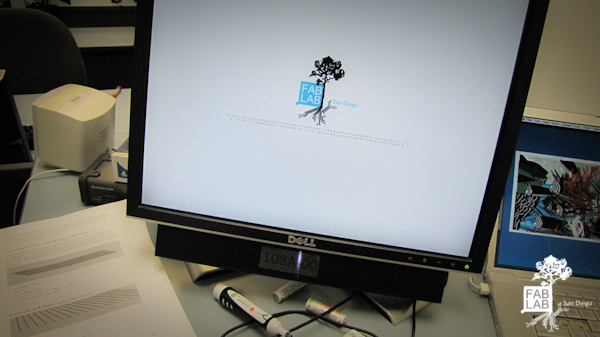 This class will introduce programming concepts to students, with no previous programming experience required, and will focus on learning to read and write programs in C++. The class will focus on in-class programming and participation. The class will move quickly and students are required to have access to a computer at home. We will cover IDEs, programming basics, compilation, execution, flow control, functions, arrays, pointers, file I/O, structures and classes.
This class will introduce programming concepts to students, with no previous programming experience required, and will focus on learning to read and write programs in C++. The class will focus on in-class programming and participation. The class will move quickly and students are required to have access to a computer at home. We will cover IDEs, programming basics, compilation, execution, flow control, functions, arrays, pointers, file I/O, structures and classes.
[Learn More…]
Introduction to Java Programming: Java Language Basics
 This week long workshop introduces the structure, syntax, and programming paradigm of the Java™ language and platform. Students will learn the Java syntax you are most likely to encounter in the professional and research world and Java programming idioms you can use to build robust, maintainable Java applications. Students will be guided through the essentials of object-oriented programming on the Java platform, including fundamental Java syntax and its use. You’ll get started with creating Java objects and adding behavior to them, and conclude with an introduction to the Java Collections Framework, with considerable ground covered in between. This course will start with the very basics and assumes that students do not have any previous Java programming experience and does not require any other programming experience. This course will cover the fundamentals of the operative parts of Java and will introduce the basic programming concepts of Java programming.
This week long workshop introduces the structure, syntax, and programming paradigm of the Java™ language and platform. Students will learn the Java syntax you are most likely to encounter in the professional and research world and Java programming idioms you can use to build robust, maintainable Java applications. Students will be guided through the essentials of object-oriented programming on the Java platform, including fundamental Java syntax and its use. You’ll get started with creating Java objects and adding behavior to them, and conclude with an introduction to the Java Collections Framework, with considerable ground covered in between. This course will start with the very basics and assumes that students do not have any previous Java programming experience and does not require any other programming experience. This course will cover the fundamentals of the operative parts of Java and will introduce the basic programming concepts of Java programming.